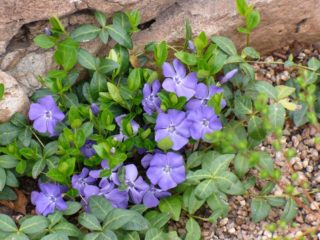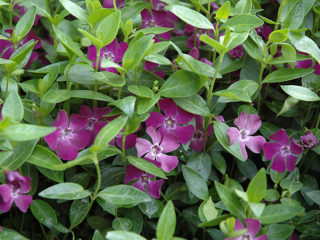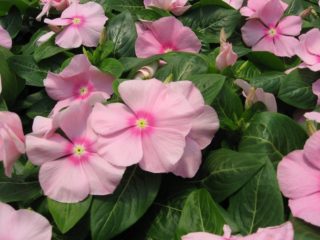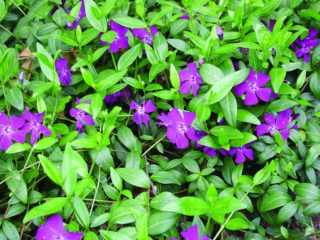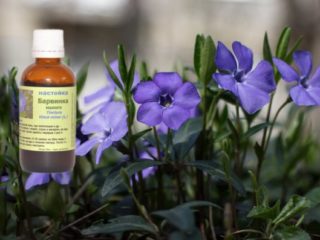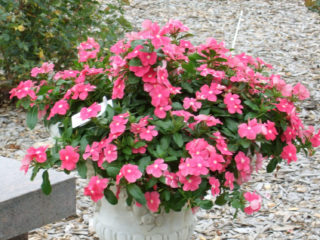Content
Herb periwinkle is a perennial creeping plant with erect shoots. Flowers of its purple hue. Shoots are collected in small shrubs. Periwinkle takes root well on soils with any composition, does not require frequent watering.

Periwinkle is unpretentious in care
Description
Herb periwinkle is often used in landscape design. Shoots are low, up to 20-30 cm. The stem is dense, leathery, bright green in color. The leaves are oppositely directed, covered with a waxy bloom, lanceolate. Located along the entire length of the shoot.
The flowers consist of 5-6 petals of bright purple color, collected in the correct rosette. The base is in the form of a cone, it contains yellow stamens. 3-4 buds are formed on one branch.
The plant belongs to creeping shrubs, cover the entire area of the earth with long shoots. Saplings are planted at a distance of 30 cm from each other so that the stems do not intertwine with each other.
Flowering lasts throughout the season, the first buds bloom in early summer. The plant continues to produce new inflorescences all summer. The life cycle of one is 15 days. At the end, seed pods are formed.
Seedling preparation
Herb periwinkle can be planted directly in open ground or seedlings can be prepared. Planting work begins in early February. Fertile soil is used to make the seeds germinate quickly. It is bought ready-made in agrotechnical stores, you can take it on your own site.
Landing takes place in several stages:
- Peat boxes or plastic glasses are prepared in advance.
- The container is two-thirds filled with earth.
- Sprinkle with water.
- 3-4 seeds are placed on the surface.
- Seeds are covered with earth, watered.
- Cover with cling film or transparent glass.
- Leave in a warm place until seeds germinate.
- Remove the film and water the seedlings.
- Seedlings are grown up to 3-4 natural leaves.
- 2 weeks before transferring to open ground, the seedlings begin to harden.
- They are taken out onto the balcony. On the first day, take out for 1 hour, then increase the time.
- When the plants stand on the balcony for 14 hours, they are transferred to open ground.
They begin to plant periwinkle when the soil warms up to 10 ° C, and the night frosts completely recede.

Herb periwinkle quickly takes root in a new place
How and when to plant in open ground
Planting works in open ground of seeds are carried out in early spring or in winter. Saplings are planted in early summer when the soil warms up.
Site selection and preparation
Periwinkle is not picky about the composition of the soil; it takes root well in sunny or shady areas. However, on fertile soil, the plant gives abundant flowering, and the bushes look more luxuriant. The following areas are suitable for a perennial:
- sublime;
- in the shade of trees;
- along the fence;
- in flower beds next to shrubs;
- along the wall of the house or gazebo.
Periwinkle makes beautiful combinations that adorn flower beds. They are combined with other herbaceous plants and bushes.
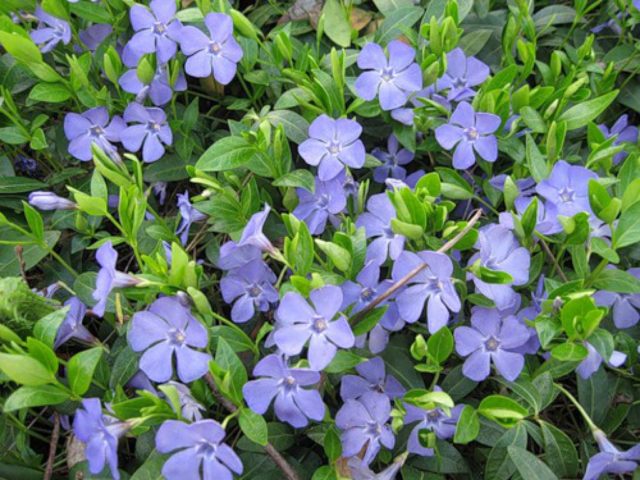
Periwinkle is drought-resistant, easily tolerates heat
Planting stages
The process of planting seeds and saplings is different. Periwinkle is a perennial plant, but it is renewed every 5 years.
Seeds
The grains are processed before planting.One seed 5 mm in size, the capsules are collected, spread out in a thin layer and air-dried. Cover with a dark cloth before planting. Leave in a warm room for 2 weeks.
In early summer, they begin planting in open ground. The seeds are sealed to a depth of 2 cm, watered, adhere to the 30 × 30 cm scheme. After 14 days, seedlings appear, the seedlings are thinned out, leaving the highest and strongest stems.
Saplings
When the seedlings have 3-4 true leaves, they can be transferred to open ground. It is important to wait until there is no risk of frost return.
Watering and feeding
Periwinkle herbaceous unpretentious, water the plant no more than 1 time in 10 days. The shrub independently consumes moisture from the groundwater. The roots of the grass penetrate deeply into the soil and reach deep waters, which allows them to easily tolerate dry times.
Top dressing is carried out three times per season. Periwinkle prefers nitrogenous fertilizers. You can use ready-made mineral complexes or fresh cow dung. The trace element helps build green mass. It is desirable that the complex includes phosphorus and potassium. They are responsible for plant immunity, stimulate flowering and active growth.
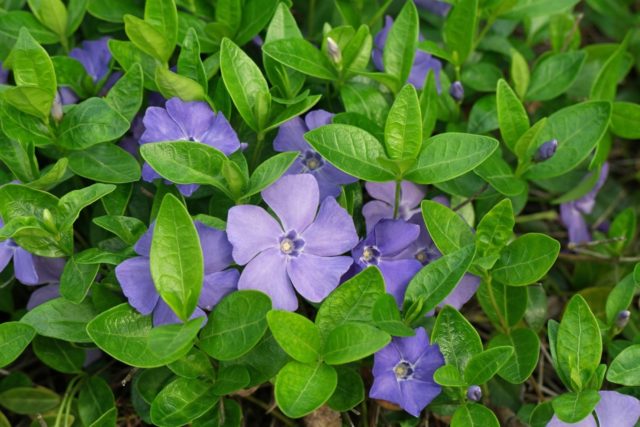
Herbaceous periwinkle is used in folk medicine
Diseases and pests
Herb periwinkle has strong immunity, however, with improper care, problems can arise. With frequent watering or excess moisture, the plant is sick with powdery mildew. A white fluffy bloom appears on the leaves. Over time, the foliage dries and falls off.
To fight the disease, use:
- fungicides;
- a solution of copper sulfate;
- herbal decoctions of garlic arrows;
- potassium permanganate solution;
- pollination with wood ash.
In addition to infection, insects can attack the plant. Aphids and scale insects often infect periwinkle foliage. They feed on periwinkle juice. Aphids are small black beetles with wings. They gnaw through the wings in the leaves, due to which the plants die.
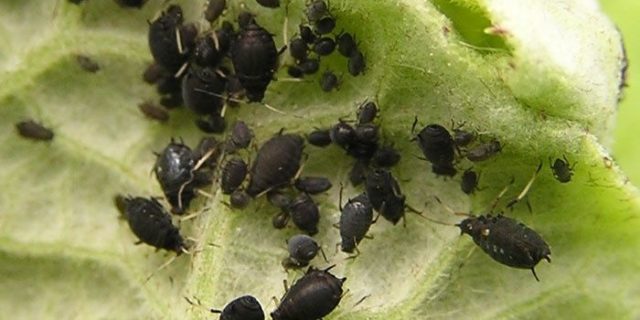
Periwinkle affects only black aphid, it multiplies quickly
Scabbards attack foliage in the summer. During this period, they multiply and are active. Insects eat the foliage, suck the juice out of it. Over time, the plant dies. You can fight them with insecticides.
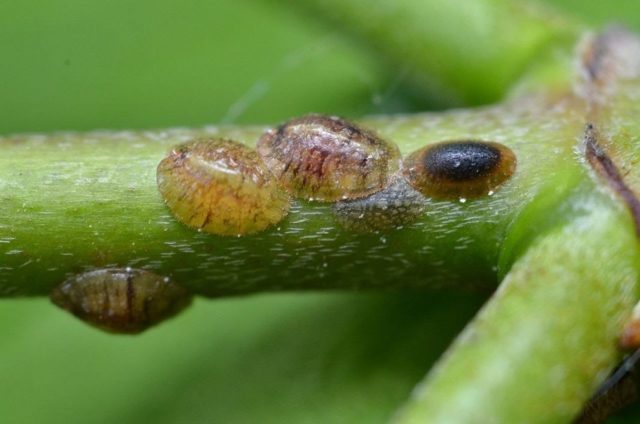
Scabbards look like small "turtles", they have a dense chitinous shell
Pruning
Since periwinkle is a perennial plant, all upper shoots are cut off for the winter. This is necessary in order to preserve the top of the bush, and in the summer it was able to give new branches. In the month of September, flower seeds are harvested. After that, the shoots are cut off. For the winter, the roots are covered to protect them from frost.
Shelter for the winter
Herb periwinkle is a winter-hardy plant. However, gardeners recommend insulating the plant's root system. This will ensure that the flower retains its properties. Usually it is mulched. Suitable for this purpose:
- fallen leaves;
- cut grass;
- moss;
- straw;
- humus.
You can also use agrofibre or spunbond. These materials are sold in agrotechnical stores.
Reproduction
Reproduction of periwinkle occurs in different ways. Each gardener selects a suitable method for him:
- By dividing the bush... This method is popular with gardeners. They dig out the bush, divide it into equal parts and plant it in new places.
- Cuttings... At the end of the season, cuttings are selected for future planting. Choose shoots not shorter than 15 cm. Cut off the branches, leave overnight in a solution of potassium permanganate. Cuttings are planted in the ground, covered with a glass jar. Leave until the roots germinate. Test them with your fingers in the soil.
- Seeds... The grains are harvested in early autumn, after the bolls are formed. Seeds are dried, planted for seedlings or in open ground. Plants take root quickly.
Most often, gardeners use bush division or cuttings. They are more reliable than growing from seed.
Photo in landscape
In landscape design, herbaceous periwinkle is used to decorate flower beds, borders and gazebos. The bush is grown in pots and taken out into the street, it goes well with other flowers. It is planted next to roses, trees, berry bushes, lungwort, forest trees, hyacinths, primrose, forget-me-nots.
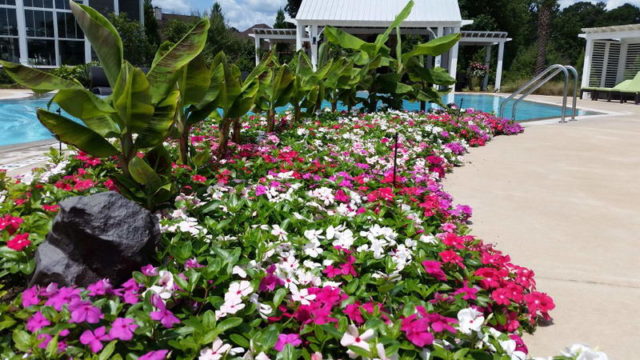
The bright color of the periwinkle will allow you to combine it with flowers of various shades

Periwinkle goes well with any plants

The plant can be used as a tree edging

The flower in combination with ampelous plants creates a harmonious composition
Application in medicine
In addition to external qualities, periwinkle has healing properties. The flower is often used in folk medicine for healing.
Plant properties:
- Restores the work of the heart muscle.
- Reduces blood pressure.
- Improves blood circulation in the brain.
- Helps cope with stressful conditions.
- Stimulates the secretion of mucus from the sinuses in case of a cold.
- Helps to cope with otitis media and nasal diseases.
- Herbal tea is prescribed for mild schizophrenia.
The healing properties of the plant have been known for many years. It is used in medicine as a dietary supplement.
Conclusion
Herb periwinkle is a perennial plant. It is unpretentious to care for. It is used for landscaping. In addition, the herb has medicinal properties. Periwinkle is grown in any conditions, bright purple flowers are combined with various shrubs.
Testimonials

